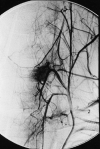Pseudohemangioma of the vertebra: an unusual radiographic manifestation of primary Ewing's sarcoma
- PMID: 10588101
- PMCID: PMC7657769
Pseudohemangioma of the vertebra: an unusual radiographic manifestation of primary Ewing's sarcoma
Abstract
Primary Ewing's sarcoma (ES) of the spine is uncommon, exhibiting a variety of appearances on plain-film radiographs and cross-sectional images. We report the unusual CT imaging manifestations of a primary ES with a coarse trabecular pattern that mimicked an aggressive hemangioma of the cervical spine.
Figures






Similar articles
-
Intradural, extramedullary spinal Ewing's sarcoma in childhood.J Clin Neurosci. 2003 Jan;10(1):122-5. doi: 10.1016/s0967-5868(02)00279-5. J Clin Neurosci. 2003. PMID: 12464543
-
Primary Ewing's sarcoma of the second cervical vertebra: a rare entity.J Pediatr Orthop B. 2011 Nov;20(6):408-12. doi: 10.1097/bpb.0b013e328345d78a. J Pediatr Orthop B. 2011. PMID: 22272383 No abstract available.
-
Osteochondroma of the cervical spine. MR findings.Clin Imaging. 1995 Oct-Dec;19(4):275-8. doi: 10.1016/0899-7071(94)00063-i. Clin Imaging. 1995. PMID: 8564873
-
Osteochondroma of the cervical spine: case report and review of the literature.Br J Neurosurg. 1994;8(3):359-63. doi: 10.3109/02688699409029627. Br J Neurosurg. 1994. PMID: 7946028 Review.
-
Extraskeletal Ewing's sarcoma: a case report and review of the literature.Spine (Phila Pa 1976). 2000 Aug 1;25(15):1996-9. doi: 10.1097/00007632-200008010-00022. Spine (Phila Pa 1976). 2000. PMID: 10908947 Review.
Cited by
-
Primary Ewing's Sarcoma of the Spine: About a Case.Glob Pediatr Health. 2022 Nov 17;9:2333794X221123874. doi: 10.1177/2333794X221123874. eCollection 2022. Glob Pediatr Health. 2022. PMID: 36420454 Free PMC article.
-
Unusual Presentation of a Primary Ewing's Sarcoma of the Spine with Paraplegia: A Case Report.J Clin Diagn Res. 2015 Mar;9(3):RD01-3. doi: 10.7860/JCDR/2015/11647.5663. Epub 2015 Mar 1. J Clin Diagn Res. 2015. PMID: 25954672 Free PMC article.
-
Vertebroplasty for vertebral hemangioma in children: a report of two cases with 2-year follow-up.Childs Nerv Syst. 2015 Nov;31(11):2179-83. doi: 10.1007/s00381-015-2777-4. Epub 2015 Jun 13. Childs Nerv Syst. 2015. PMID: 26070966
-
Primary Ewing's sarcoma of the vertebral column.Skeletal Radiol. 2004 Sep;33(9):506-13. doi: 10.1007/s00256-004-0810-x. Epub 2004 Jun 30. Skeletal Radiol. 2004. PMID: 15232658
-
Primary Ewing's sarcoma of the spine presenting as acute paraplegia.J Pediatr Neurosci. 2012 Jan;7(1):64-6. doi: 10.4103/1817-1745.97630. J Pediatr Neurosci. 2012. PMID: 22837785 Free PMC article.
References
-
- Amour TE, Hodges SC, Laakman RW, Tamas DE, Other primary extradural tumors. In: MRI of the Spine. Amour TE, Hodges SC, Laakman RW, Tamas DE, eds, New York: Raven Press; 1994:509–516
-
- Grubb MR, Currier BL, Prichard DJ, Ebersold MJ, Primary Ewing's sarcoma of the spine. Spine 1994;19:309-311 - PubMed
-
- Whitehouse GH, Griffiths GJ, Roentgenological aspects of spinal involvement by primary and metastatic Ewing's tumor. J Can Assoc Radiol 1976;27:290-297 - PubMed
-
- Twohig M, Sze G, Spinal tumors. In: Magnetic Resonance Imaging of Children. Cohen MD, Edwards, MK, eds. Philadelphia: BC Decker Inc; 1990:463–498
-
- Fechner RE, Mills SM, Small cell sarcomas. In: Tumors of the Bones and Joints. Fechner RE, Mills SM, eds. Washington, DC: Armed Forces Institute of Pathology; 1993:87–202
Publication types
MeSH terms
LinkOut - more resources
Full Text Sources
Medical
